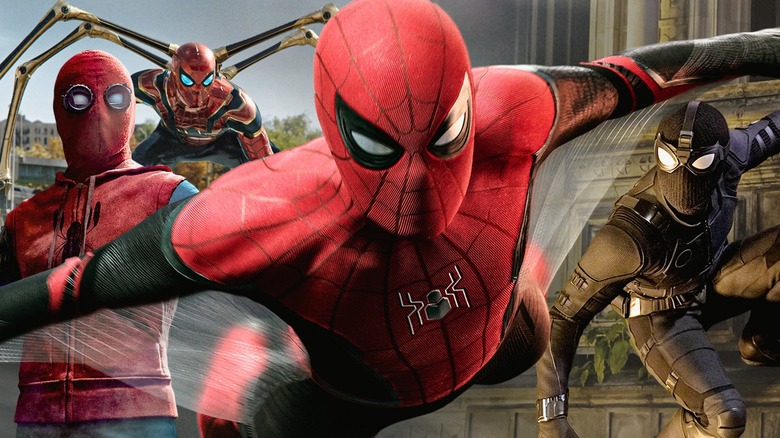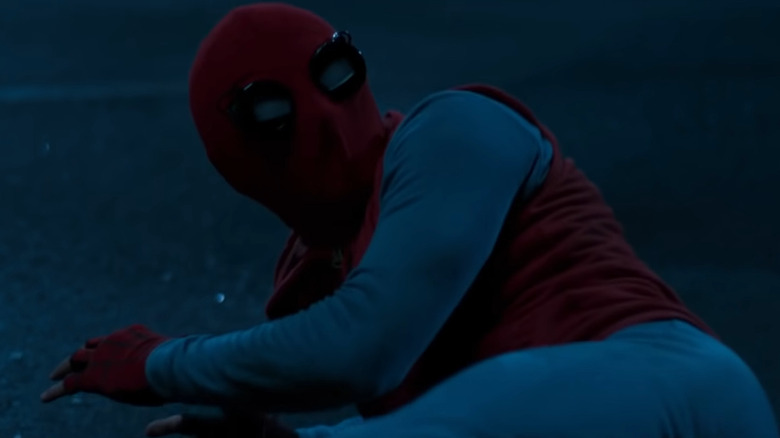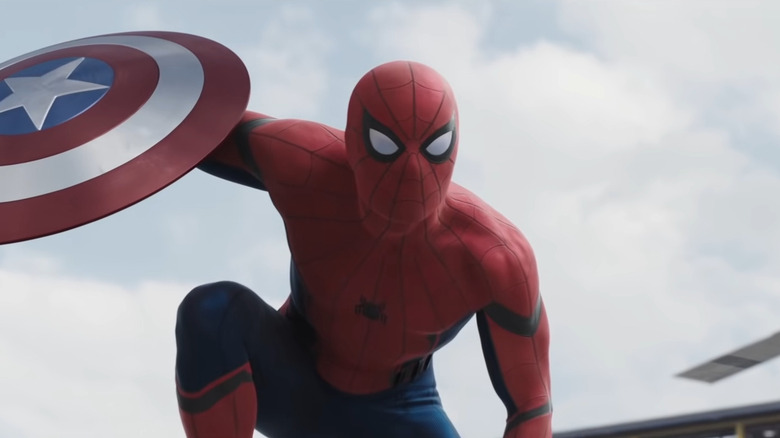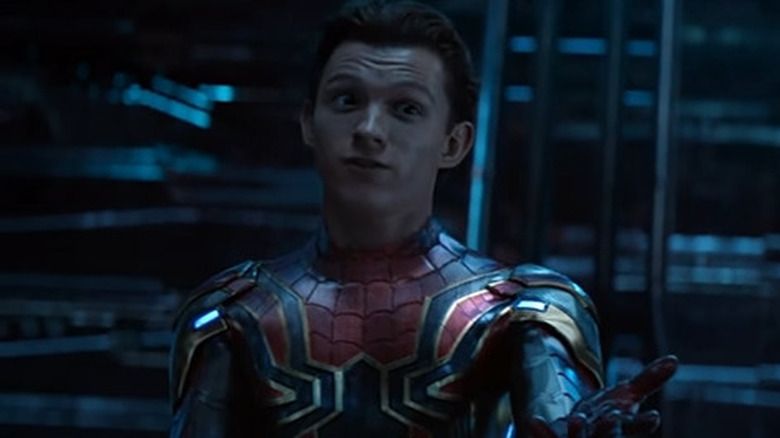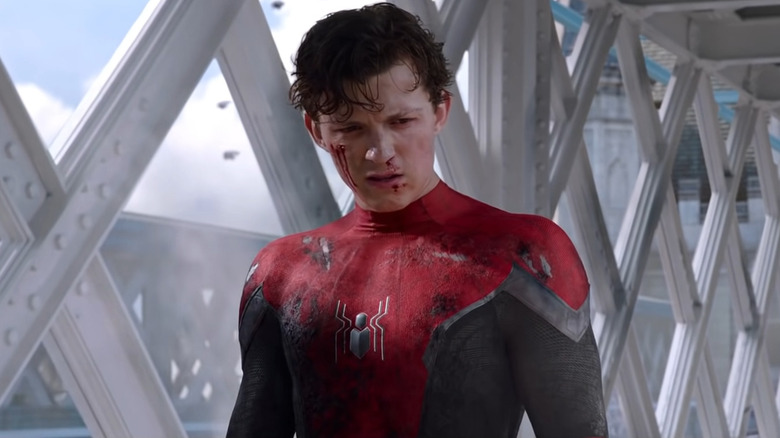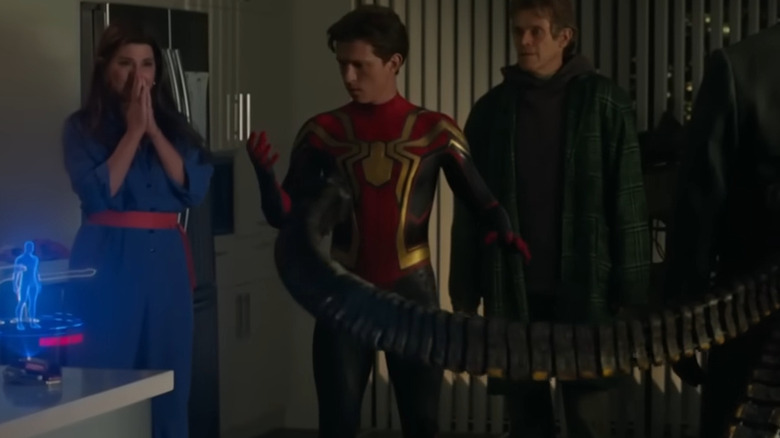The Meaning Behind Spider-Man's MCU Costumes, Explained
A Marvel Studios sequel just wouldn't be complete without a brand-new costume for its titular hero to wear. From the simple super soldier Steve Rogers (Chris Evans) to Tony Stark (Robert Downey Jr.) and his all-iron wardrobe, it seems compulsory that the Avengers and their collaborators never be caught repeating outfits.
The primary reason for these constant costume changes is, almost definitely, boosting toy sales. After all, the studio reportedly chose Iron Man as its flagship hero because it was determined that his armory would best translate into a bankable toy line — and when it came time for his billion-dollar threequel, the apparent need to sell action figures forced director Shane Black to rewrite the female villain as male.
As dystopian as these plastic constraints sound, it's possible for a particularly creative director to take advantage of the quasi-required costume changes to emphasize the story being told. And no Marvel director exemplifies this usually untapped potential more than Jon Watts, who collaborated with costume designers and concept artists to weave Peter Parker's (Tom Holland) journey into the threads of his many Spidey suits.
The homemade suit represents Peter Parker's inherent heroism
First seen in brief flashes in "Captain America: Civil War," Peter Parker's homemade suit was designed by Judianna Makovsky from a concept created by Marvel Studios Head of Visual Development Ryan Meinerding. Crudely composed of sweats and some ingeniously simple technology for the eyes, it perfectly represents what a teenage superhero — working with an intellect that far outsizes his budget — would feasibly be able to create on his own.
The homemade suit is imbued with its greatest thematic meaning in "Spider-Man: Homecoming," Jon Watts' first entry in his "Spider-Man" trilogy. Here, it is used to emphasize Peter's inner growth throughout the story, in which he learns that, even stripped of his fancy Stark tech and Avenger-in-training privileges, he's still worthy of being a hero.
In other words, it's a lasting reminder of the 15-year-old kid from Queens who accepts the responsibility to help others, even when he has nothing. The homemade suit represents the very core of Spider-Man's characterization in the Marvel Cinematic Universe, and the fact that he defiantly returns to it in order to stop Vulture (Michael Keaton) in the film's finale makes its use all the more poignant.
The Stark suit exemplifies how far Peter has come and how far he has to go
Another Judianna Makovsky–Ryan Meinerding collaboration held over from "Captain America: Civil War," the Stark suit is likely the costume fans most commonly associate with the MCU iteration of Spider-Man. It's featured prominently in his first three appearances and — until the end of "Spider-Man: No Way Home" — feels closest to the character's classic red-and-blue comic book design.
Ironically, in the context of "Spider-Man: Homecoming," there's absolutely nothing "classic" about this Spidey suit, which was created by Tony Stark ahead of their battle against Captain America in Germany. Its inner workings are so alien to Peter (and the audience, for that matter) that he's prohibited from accessing most of its functions for a majority of the film and never gets a handle on its full potential. As such, the Stark suit represents Peter's desire to be an Avenger while constantly reminding him how far he has to go to achieve that goal.
That said, when Tony takes the suit from him following a disastrous ferry squabble, Peter's return to the homemade suit proves that he doesn't need to be an Avenger to be a hero. This lesson is further emphasized by the final choice Peter makes in the film: rejecting another Spidey suit.
The Iron Spider armor makes Peter an Avenger
Peter Parker's second Stark-made Spidey suit is the Iron Spider armor, a significant upgrade that closes the gap between friendly neighborhood Spider-Man and Avenger. Since there was seemingly no physical Iron Spider costume on set (behind-the-scenes photos show Tom Holland in a motion capture suit while the Iron Spider armor is in action), it was pretty much the sole creation of Ryan Meinerding, loosely inspired by the Iron Spider armor in the comics as designed by Joe Quesada.
For Holland's Peter, the Iron Spider armor represents everything he thought he wanted at the beginning of "Spider-Man: Homecoming" — that Avengers-level worthiness coupled with the capability to fight bigger, badder threats. When he dons it in "Avengers: Infinity War," however, it's given to him not because he's finally ready but out of necessity — given that he's falling from the sky — emphasizing how the responsibility to fight the universal threat that is Thanos (Josh Brolin) is thrust upon him.
In "Spider-Man: Far from Home," the Iron Spider armor has replaced Peter's primary Stark suit, perhaps symbolizing that Peter feels he can't be a friendly neighborhood Spider-Man anymore, much less a normal kid. Coupled with his grief over Tony's death, the Iron Spider armor comes to represent the dream he achieved and the price he paid for it.
Far from Home's costumes mirror Peter's identity crisis after Tony Stark's death
When we first encounter Peter Parker in "Far from Home," he's suffering from a trauma-induced identity crisis. In the aftermath of his battle with Thanos' army and Tony Stark's death, he desperately wants to go back to being a normal kid, at least on his summer trip to Europe. This desire is symbolized by his choice to leave the Iron Spider armor in America.
When Nick Fury (or at least a Skrull pretending to be him, still played by Samuel L. Jackson) forces him to join the fight against the Elementals, he dons an all-black stealth suit (designed by Ryan Meinerding and "Far from Home" costume designer Anna B. Sheppard). Jon Watts joked in an interview with Entertainment Weekly that it looks like a Black Widow suit tailored to fit him, which echoes the suit's purpose in the film.
Later, during Peter's first fight with Mysterio (Jake Gyllenhaal), the villain psychologically torments him by needling his vulnerable sense of self — an assault emphasized by Mysterio continually switching up the version of the suit the wall-crawler appears to be wearing as he pummels him. Finally, in order to defeat Mysterio at the end of the film, Peter steps into his power by creating his own Stark tech Spidey suit, the Upgraded Suit, symbolizing his newfound confidence. The black detailing, possibly representing his acceptance of Tony's death, is a nice touch as well.
No Way Home brings Peter's best qualities together and proves he's finally his own hero
The dramaturgical purpose of "No Way Home" is to synthesize the elements of growth experienced by Tom Holland's Peter Parker and finally evolve him into a self-defined superhero. It's rather fitting, then, that his final outfit, a combination of the Upgraded Suit and the Iron Spider armor, is called the Integrated Suit and is made not by Tony Stark or Peter himself but by Dr. Otto Octavius (Alfred Molina) after Peter develops a cure for the artificially intelligent tentacles having taken control of the scientist's brain. While the Iron Spider armor had been given to him out of necessity, Peter now earns his Avengers-level prestige not by defeating aliens or using Stark technology, but by making the merciful choice to save his enemies' lives.
In a series maligned for allowing Peter's identity to be defined in part by his iron mentor, this moment in "No Way Home" proves the journey's end point was Spider-Man becoming a superhero in his own right and by his own standards. He completes this journey during the film's last moments, when he creates his own suit from scratch. While its sleek design is evidence of the character's growth over the past three films, it seemingly represents most of what the original homemade suit does: that even without the gadgets and armor, it's his willingness to do the right thing that truly makes Peter Parker Spider-Man.
